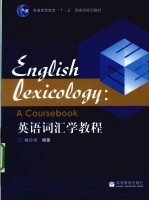图书介绍
英语词汇学教程PDF|Epub|txt|kindle电子书版本网盘下载

- 杨信彰编著 著
- 出版社: 北京:高等教育出版社
- ISBN:9787040252583
- 出版时间:2009
- 标注页数:149页
- 文件大小:37MB
- 文件页数:164页
- 主题词:英语-词汇学-高等学校-教材
PDF下载
下载说明
英语词汇学教程PDF格式电子书版下载
下载的文件为RAR压缩包。需要使用解压软件进行解压得到PDF格式图书。建议使用BT下载工具Free Download Manager进行下载,简称FDM(免费,没有广告,支持多平台)。本站资源全部打包为BT种子。所以需要使用专业的BT下载软件进行下载。如BitComet qBittorrent uTorrent等BT下载工具。迅雷目前由于本站不是热门资源。不推荐使用!后期资源热门了。安装了迅雷也可以迅雷进行下载!
(文件页数 要大于 标注页数,上中下等多册电子书除外)
注意:本站所有压缩包均有解压码: 点击下载压缩包解压工具
图书目录
Chapter 1 Lexicology and Words1
1.1 Introduction1
1.2 What Is Lexicology?1
1.2.1 Morphology and Semantics1
1.2.2 Etymology and Lexicography2
1.3 What Is a Word?3
1.3.1 Difficulties in the Definition of the Word3
1.3.2 Major Features of Words5
1.4 Words in Linguistic Analysis7
1.5 Word Classes8
1.6 Lexical and Grammatical Words9
1.7 Words and Semantic Fields10
Exercises13
Chapter 2 Some Basic Concepts and Word Meanings15
2.1 Introduction15
2.2 Morpheme,Lexeme and Morph15
2.2.1 Morpheme15
2.2.2 Lexeme17
2.2.3 Morph17
2.2.4 Types of Morphemes19
2.3 Word Meanings19
2.3.1 Denotation and Reference20
2.3.2 Denotation and Sense20
2.4 Seven types of Meaning21
2.4.1 Conceptual Meaning21
2.4.2 Connotative Meaning21
2.4.3 Social and Affective Meanings22
2.4.4 Reflected and Collocative Meanings23
2.4.5 Thematic Meaning23
2.5 Root and Stem24
2.6 Polysemy26
2.7 Homonymy27
Exercises29
Chapter 3 The Origins of English Words31
3.1 Introduction31
3.2 The Development of English31
3.3 The Historical Periods of English33
3.3.1 Old English Period(450-1066)33
3.3.2 The Middle English Period(1066-1500)35
3.3.3 Early Modern English Period(1500-1800)37
3.3.4 The Modern English Period(1800-present)39
3.4 American English40
3.5 Native English Vocabulary41
3.6 Major Influences on English43
3.6.1 The Scandinavian Influence43
3.6.2 The Norman Conquest44
3.6.3 The Latin Influence45
3.7 Borrowings in English46
3.7.1 Latin words in English47
3.7.2 Greek and French Loanwords48
3.7.3 German,Dutch and Italian Loanwords49
3.7.4 Loanwords from the East50
3.7.5 Loanwords from Other Sources50
3.8 The Size of English Vocabulary51
3.9 Creation of New English Words51
3.9.1 Root Creation52
3.9.2 Onomatopoeic words and Ejaculations52
3.9.3 Word formation52
Exercises53
Chapter 4 Word Formation in English54
4.1 Introduction54
4.2 Inflection and Derivation55
4.2.1 Definition of Inflection55
4.2.2 Functions of Inflection56
4.2.3 Derivational Affix57
4.2.4 Functions of Derivations57
4.2.5 Types of Derivational Affix58
4.3 Compounding61
4.3.1 Definition of Compounding62
4.3.2 Characteristics of Compounds62
4.3.3 Common Patterns of compounds64
4.4 Other Word-formation Processes67
4.4.1 Conversion67
4.4.2 Blending68
4.4.3 Shortenings70
4.5 Backformation73
4.6 Words from Proper Names and Metanalysis74
4.6.1 Words from Proper Names74
4.6.2 Metanalysis75
Exercises76
Chapter 5 Sense Relations78
5.1 Introduction78
5.2 Characteristics of Sense Relations78
5.3 Synonymy79
5.3.1 Two Types of Synonymy79
5.3.2 Difference Among Synonyms80
5.4 Antonymy82
5.4.1 Gradable Antonyms83
5.4.2 Complementary Antonyms84
5.4.3 Converse antonyms84
5.5 Hyponymy85
5.6 Meronymy86
5.7 Collocation86
5.7.1 Free and Fixed Combinations87
5.7.2 Grammatical Collocations87
5.7.3 Lexical Collocations87
5.7.4 Other Features of Collocation88
5.8 Metaphorical Extension89
Exercises89
Chapter 6 Idioms,Multiword Verbs and Proverbs91
6.1 Introduction91
6.2 Idioms91
6.2.1 Classification of Idioms92
6.2.2 Different Aspects of Idioms93
6.3 Multiword verbs95
6.4 Proverbs97
Exercises99
Chapter 7 English Dictionaries100
7.1 Introduction100
7.2 Organization of the Entry100
7.2.1 Headword101
7.2.2 Pronunciation101
7.2.3 Grammatical Information102
7.2.4 Etymology102
7.2.5 Definition103
7.2.6 Examples104
7.2.7 Related Forms and Usage Labels104
7.2.8 Illustrations105
7.2.9 Supplementary Matter105
7.3 Corpora106
7.4 Dictionary Shelf-life107
7.5 Types of Dictionaries107
7.5.1 General and Specialized Dictionaries107
7.5.2 Monolingual and Bilingual dictionaries108
7.5.3 Electronic and Print Dictionaries108
7.5.4 Unabridged Dictionaries109
7.5.5 Learner's Dictionaries and Children's Dictionaries109
7.5.6 Thesaurus110
7.6 A Review of Some Dictionaries110
7.6.1 The Oxford English Dictionary110
7.6.2 Webster's Third New International Dictionary of the English Language111
7.6.3 The Chambers Dictionary112
7.6.4 Random House Webster's College Dictionary112
7.6.5 Oxford Advanced Learner's Dictionary112
7.6.6 Longman Dictionary of Contemporary English113
7.6.7 Collins COBUILD English Dictionary114
7.6.8 Macmillan English Dictionary for Advanced Learners115
7.6.9 A New English-Chinese Dictionary and the English-Chinese Dictionary116
Exercises116
Chapter 8 Words in Context118
8.1 Introduction118
8.2 Dialect118
8.3 Register and Style119
8.4 Taboo Words and Euphemisms120
8.4.1 Taboo Words120
8.4.2 Euphemisms121
8.4.3 Classification of Euphemisms122
8.4.4 The Use of Euphemisms122
8.5 Slang124
8.6 Jargon126
8.7 Meaning Shifts127
8.7.1 Broadening127
8.7.2 Narrowing127
8.7.3 Amelioration and Pejoration128
Exercises130
Chapter 9 English Words and Cognition132
9.1 Introduction132
9.2 The Mental Lexicon132
9.3 Metaphor133
9.3.1 Cognitive Interpretation of Metaphor134
9.3.2 Cognitive Modeling of Metaphor135
9.4 Spatial Terms and Spatial Relationships136
9.4.1 The Flexibility of Spatial Terms137
9.4.2 Cognitive Mappings of Spatial Terms138
9.5 Prototype and Radial Categories139
9.5.1 Radiality and the Meaning of the Suffix-able140
9.5.2 Radiality in Attributes141
Exercises143
References144